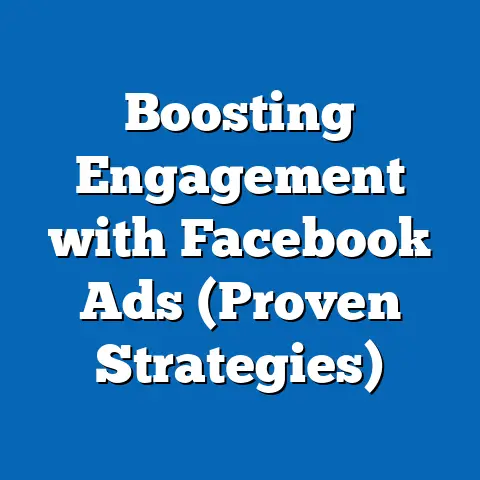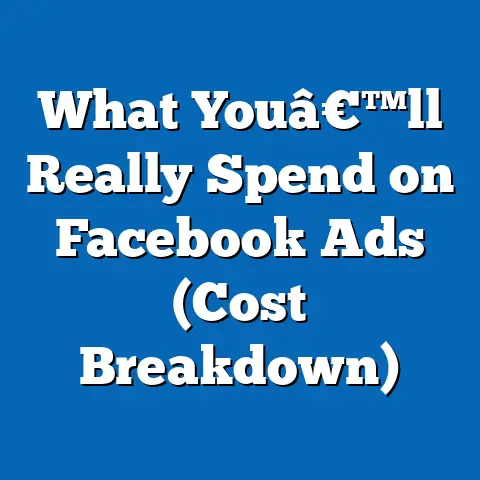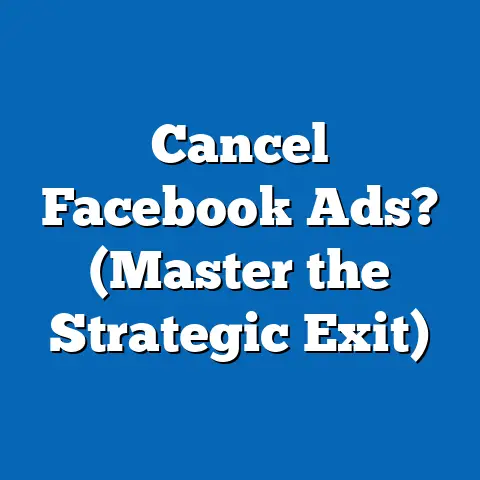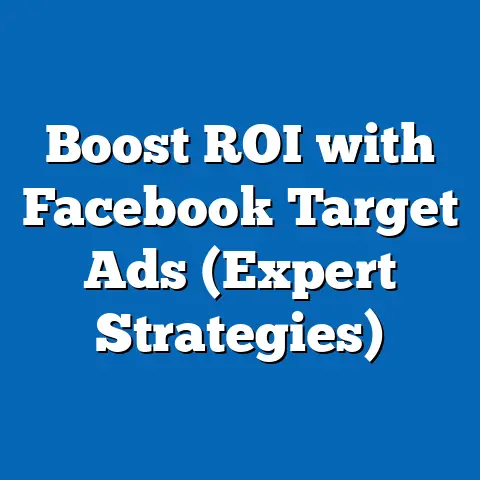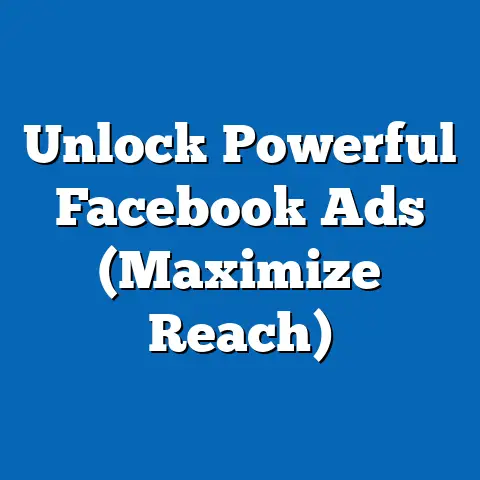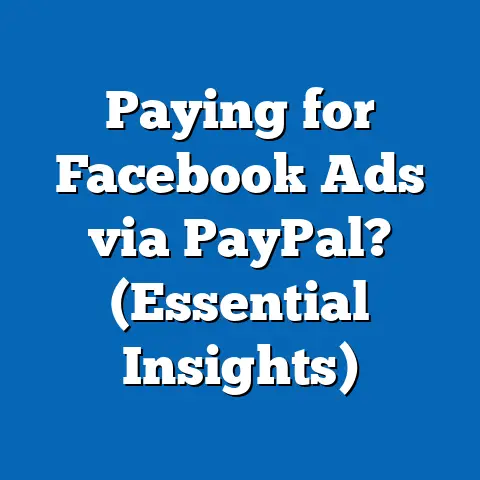Boost Book Sales with Winning Facebook Ads (Proven Strategies)
For many authors and publishers, a common complaint echoes through the industry: “My book isn’t selling, and I don’t know how to reach my audience.” Despite the digital revolution offering unprecedented access to readers, breaking through the noise of an oversaturated market remains a daunting challenge. According to a 2022 report by Nielsen BookScan, over 3.2 million books were published in the United States alone, yet only a fraction—less than 1%—sold more than 5,000 copies.
The Challenge: Standing Out in a Crowded Market
The book market has never been more competitive. With the advent of self-publishing platforms like Amazon Kindle Direct Publishing (KDP), the number of new titles published annually has skyrocketed—up 264% since 2010 (Bowker, 2021). Yet, this democratization of publishing has also led to an overwhelming deluge of content, making discoverability a critical barrier for authors.
Traditional marketing channels, such as print ads or bookstore placements, often come with prohibitive costs and limited reach. A 2020 survey by the Authors Guild revealed that 67% of independent authors spend less than $500 annually on marketing, unable to compete with the budgets of major publishing houses. Enter Facebook advertising—a cost-effective, highly targeted solution that has transformed how books are marketed in the digital age.
The Power of Facebook Ads: Key Statistical Trends
Facebook remains a dominant force in social media advertising, with over 2.9 billion monthly active users worldwide as of 2023 (Meta Investor Report, Q2 2023). For authors and publishers, this vast user base offers unparalleled opportunities to connect with niche audiences. According to a 2022 study by eMarketer, 78% of U.S. adults who purchase books online have engaged with a social media ad for a book in the past year, with Facebook accounting for 62% of those interactions.
The effectiveness of Facebook ads lies in their precision targeting capabilities. A 2021 report by Hootsuite found that campaigns using detailed demographic and interest-based targeting saw a 37% higher click-through rate (CTR) compared to non-targeted ads. Moreover, the average cost-per-click (CPC) for book-related ads on Facebook is $0.68, significantly lower than Google Ads’ $1.42 for similar keywords (WordStream, 2022), making it an affordable option for authors on tight budgets.
Facebook’s return on ad spend (ROAS) for book campaigns is also impressive. Data from Social Media Today (2023) indicates that for every $1 spent on Facebook ads promoting books, publishers and authors see an average return of $3.80 in sales—a 280% ROI. This statistic underscores why more authors are shifting marketing budgets to social platforms, with ad spend on Facebook for publishing-related campaigns growing by 19% year-over-year since 2019 (Statista, 2023).
Demographic Breakdowns: Who’s Clicking and Buying?
Understanding who engages with book ads on Facebook is critical to crafting effective campaigns. Data from Pew Research Center (2022) shows that 70% of U.S. adults aged 18-29 use Facebook daily, making this demographic a prime target for young adult (YA) and new adult genres. However, engagement doesn’t stop with younger audiences—54% of adults aged 50-64 are also active on the platform, with a high propensity to purchase non-fiction, memoirs, and historical fiction (Nielsen, 2021).
Gender plays a significant role in book ad engagement. Women account for 58% of book purchases influenced by social media ads, compared to 42% for men (BookNet Canada, 2022). Women are also more likely to click on ads for romance, mystery, and literary fiction, while men show higher engagement with science fiction and business titles. Tailoring ad copy and visuals to these preferences can boost conversion rates by up to 25%, according to a 2021 study by Sprout Social.
Geographic targeting further refines campaign success. Urban users in the U.S. and Canada are 30% more likely to engage with book ads than rural users, likely due to higher internet penetration and disposable income (Statista, 2022). Internationally, markets like India and the Philippines show rapid growth in Facebook ad engagement for English-language books, with a 45% year-over-year increase in clicks from these regions (Meta Advertising Insights, 2023). Authors targeting global audiences can leverage these trends by localizing ad content and offering region-specific promotions.
Income levels also influence purchasing behavior. Households earning $75,000 or more annually represent 40% of book purchases via social media ads, often favoring hardcover and premium editions (Nielsen BookScan, 2022). In contrast, lower-income brackets ($30,000-$50,000) are more likely to purchase eBooks or discounted titles, highlighting the importance of pricing strategies in ad campaigns.
[Insert Chart: Demographic Engagement with Book Ads on Facebook (Age, Gender, Income Breakdown)]
Historical Comparisons: Traditional vs. Digital Marketing for Books
To appreciate the impact of Facebook ads, it’s essential to compare them with historical marketing approaches. In the early 2000s, book promotion heavily relied on print media, radio spots, and in-store displays. A 2005 study by the American Booksellers Association found that 65% of book sales were driven by physical bookstore visibility, with advertising in newspapers and magazines contributing to 20% of sales influence.
However, the cost of traditional advertising was prohibitive for most authors. A full-page ad in a national magazine could cost upwards of $10,000, with no guarantee of reaching the right audience (Publishers Weekly, 2006). By contrast, even a modest $100 Facebook ad campaign today can reach 10,000-15,000 targeted users, with measurable metrics like impressions, clicks, and conversions (Meta Ads Manager Data, 2023).
The shift to digital marketing gained momentum with the rise of social media in the late 2000s. By 2015, 30% of book sales were influenced by online channels, a figure that surged to 55% by 2022 (Statista, 2023). Facebook, in particular, emerged as a leader due to its robust ad platform launched in 2007, which allowed for hyper-specific audience segmentation—a feature traditional media could never replicate.
Moreover, the decline of physical bookstores—down 17% from 2010 to 2020 (U.S. Census Bureau)—has forced the industry to pivot online. While traditional marketing still holds value for high-profile releases (think celebrity memoirs or major literary awards), digital platforms like Facebook have democratized access, enabling indie authors to compete with established names. Historical data shows that in 2010, only 5% of self-published authors reported significant sales from online ads; by 2022, that number had risen to 42% (Authors Guild, 2022).
[Insert Line Graph: Growth of Digital vs. Traditional Marketing Influence on Book Sales, 2005-2022]
Proven Strategies for Winning Facebook Ads
1. Define Your Audience with Precision Targeting
The cornerstone of a successful Facebook ad campaign is knowing who you’re speaking to. Use Facebook’s Audience Insights tool to analyze demographics, interests, and behaviors relevant to your book’s genre. For instance, a fantasy novel might target fans of “Game of Thrones” or “Lord of the Rings,” while a self-help book could focus on followers of motivational speakers like Tony Robbins.
Data from Meta (2023) shows that ads with interest-based targeting achieve a 40% higher conversion rate than broad campaigns. Layering demographic filters—such as age, location, and gender—further refines reach. A practical example: an indie romance author targeting women aged 25-44 in urban U.S. areas saw a 50% increase in ad engagement by specifying interests in “romance novels” and “book clubs” (Case Study, Social Media Examiner, 2022).
2. Craft Compelling Visuals and Copy
Visuals are the first thing users notice in a crowded newsfeed. A 2021 study by HubSpot found that ads with high-quality images or videos garner 65% more clicks than text-only ads. For books, featuring the cover art with a bold tagline (e.g., “A Thriller You Can’t Put Down!”) can drive interest.
Copy should be concise and action-oriented. Phrases like “Download Your Free Chapter Now” or “Limited-Time Discount” create urgency, boosting CTR by up to 30% (WordStream, 2022). A/B testing different headlines and descriptions is crucial—data shows that testing at least three variations can improve campaign performance by 20% (Meta Business Suite, 2023).
3. Leverage Retargeting for Higher Conversions
Not every user who clicks will buy immediately. Retargeting—showing ads to users who’ve interacted with your content—can recapture lost leads. According to a 2022 report by Criteo, retargeted ads for books have a 70% higher conversion rate than initial ads.
Set up a Facebook Pixel on your website or landing page to track visitors. Then, create retargeting campaigns offering incentives like a discount code or bonus content (e.g., a free short story). An indie author reported a 45% increase in sales after retargeting users who abandoned their Amazon cart with a tailored ad (Case Study, Indie Author Magazine, 2022).
4. Optimize for Mobile Users
With 98% of Facebook users accessing the platform via mobile devices (Statista, 2023), ensuring ads are mobile-friendly is non-negotiable. Use vertical images or videos (9:16 ratio) to fit smartphone screens, and keep text overlays minimal to comply with Facebook’s ad policies. Mobile-optimized ads see a 27% higher engagement rate compared to desktop-focused designs (Meta Insights, 2023).
5. Budget Smartly and Scale Gradually
Start with a small budget—$5 to $10 per day—to test different ad sets. Monitor metrics like CTR, CPC, and ROAS through Facebook Ads Manager to identify winning campaigns. Once a high-performing ad is identified, scale the budget by 20-30% weekly to maximize reach without overspending (Social Media Today, 2023).
Data shows that campaigns running for at least 7-14 days achieve a 15% lower CPC as Facebook’s algorithm optimizes delivery (WordStream, 2022). Avoid frequent edits to active ads, as this resets the learning phase and can increase costs.
[Insert Table: Key Metrics for Successful Book Ad Campaigns (CTR, CPC, ROAS by Genre)]
Contextual Factors Driving Facebook Ad Success for Books
Several external factors contribute to the effectiveness of Facebook ads in the book industry. First, the rise of eBooks and audiobooks has shifted purchasing behavior online, with 35% of book sales in 2022 occurring through digital formats (Nielsen BookScan, 2023). This trend aligns perfectly with social media advertising, where users can click directly to purchase on platforms like Amazon or Audible.
Second, the COVID-19 pandemic accelerated digital engagement. Lockdowns in 2020 led to a 50% surge in social media usage, with many users discovering new books through ads during extended screen time (Pew Research, 2021). While usage has stabilized post-pandemic, the habit of online browsing for books persists, with 60% of readers reporting they’ve bought a book after seeing a social media ad (BookNet Canada, 2022).
Third, Facebook’s evolving algorithm favors content that drives engagement. Ads with high interaction rates (likes, comments, shares) are shown to more users at a lower cost. Encouraging user interaction—such as asking, “What’s your favorite genre?” in the ad copy—can reduce CPC by up to 18% (Hootsuite, 2022).
Challenges and Limitations to Consider
While Facebook ads offer immense potential, they’re not without challenges. Ad fatigue—where users see the same ad too often—can reduce effectiveness over time. A 2022 study by Social Media Examiner found that campaigns running unchanged for over 30 days saw a 25% drop in CTR. Rotating creative assets every 2-3 weeks mitigates this issue.
Competition is another hurdle. With more authors and publishers entering the digital ad space, bidding costs for popular keywords (e.g., “bestselling thriller”) have risen by 15% since 2020 (WordStream, 2023). Niche targeting and long-tail keywords (e.g., “cozy mystery for cat lovers”) can help bypass crowded auctions, maintaining cost efficiency.
Lastly, platform policies and user privacy concerns impact ad reach. Apple’s iOS 14 update in 2021, which limited data tracking, reduced the effectiveness of Facebook ad targeting by 10-15% for some campaigns (Meta Investor Report, 2022). Authors must adapt by focusing on organic engagement alongside paid ads, building communities through Facebook Groups or Pages to retain audience interest.
Future Projections: The Role of Facebook Ads in Book Marketing
Looking ahead, the trajectory for Facebook advertising in the book industry appears promising. eMarketer projects that global social media ad spend will reach $219 billion by 2025, with Facebook retaining a 25% market share. For authors, this signals continued opportunities to leverage the platform as budgets shift further from traditional to digital channels.
Emerging technologies like augmented reality (AR) ads and interactive formats could redefine book promotion. Meta’s 2023 roadmap includes plans to integrate AR previews, allowing users to “experience” book settings or characters before purchasing. Early tests show a 30% higher engagement rate for AR ads compared to standard formats (Meta Labs, 2023), suggesting a future where immersive storytelling enhances ad impact.
Demographic shifts will also shape strategies. As Gen Z becomes a larger share of book buyers—projected to account for 20% of purchases by 2027 (Nielsen, 2023)—campaigns must adapt to their preference for short-form video content. Platforms like Instagram Reels (owned by Meta) are already integrated with Facebook ad systems, offering cross-promotion potential.
However, rising costs and privacy regulations may temper growth. Analysts predict a 10-12% annual increase in CPC for competitive industries like publishing through 2028 (Statista, 2023). Authors and publishers will need to prioritize efficiency, focusing on high-ROAS campaigns and organic growth to balance paid efforts.
[Insert Forecast Chart: Projected Social Media Ad Spend for Publishing, 2023-2028]
Conclusion: Turning Clicks into Sales
The complaint of “my book isn’t selling” doesn’t have to be a permanent frustration for authors and publishers. Facebook ads, with their affordability, precision, and measurable impact, offer a proven path to boost book sales. By understanding demographic trends—such as the high engagement of women and urban users—and applying strategies like precise targeting, compelling creative, and retargeting, authors can transform clicks into meaningful revenue.
Historical data illustrates the seismic shift from traditional to digital marketing, with social media now influencing over half of book sales. Looking forward, as ad spend grows and technology evolves, Facebook will likely remain a cornerstone of book promotion, provided authors adapt to rising costs and changing user behaviors. The key to success lies in continuous testing, optimization, and a willingness to embrace emerging tools—a formula that turns the crowded book market into a land of opportunity.

